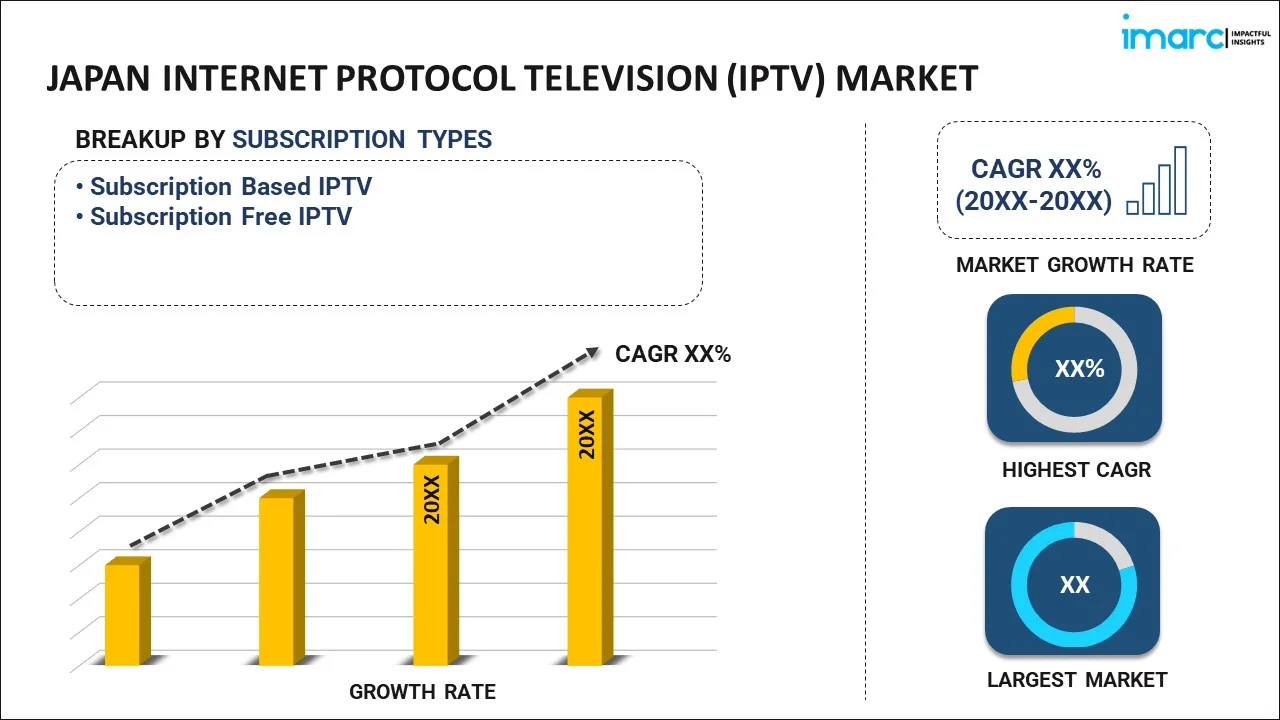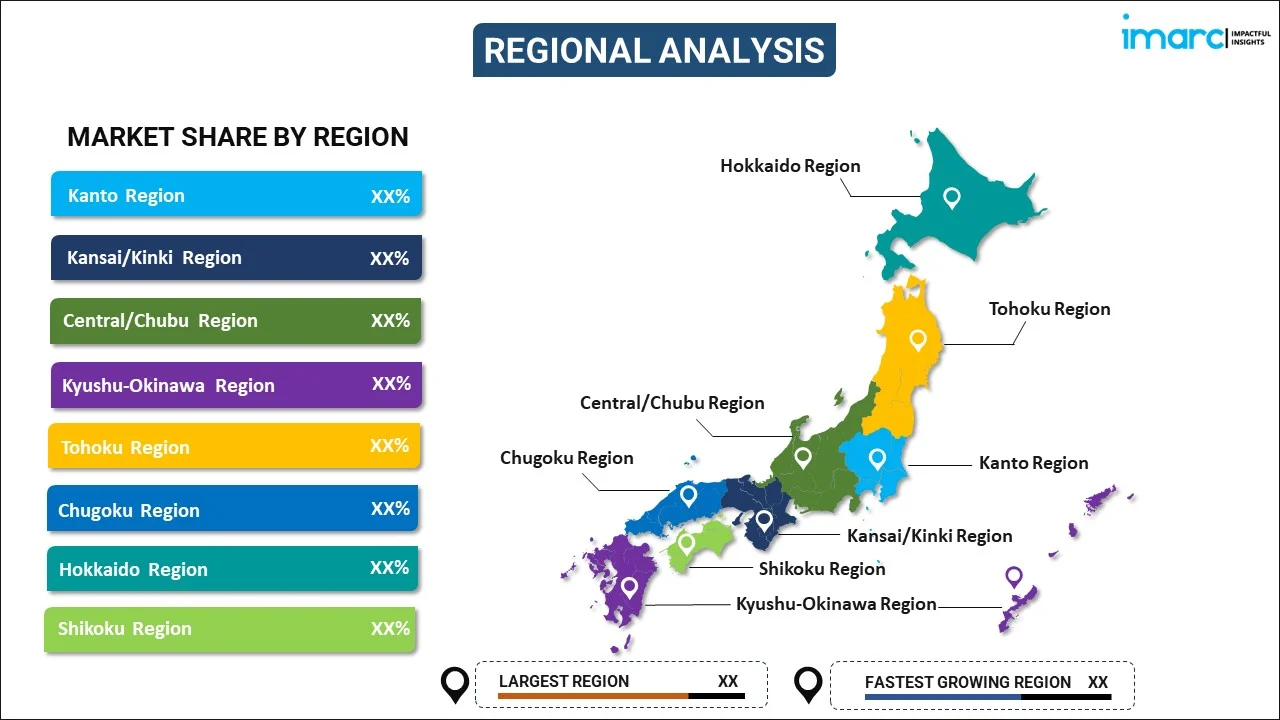
Japan Internet Protocol Television (IPTV) Market Report by Subscription Type (Subscription Based IPTV, Subscription Free IPTV), Transmission Type (Wired, Wireless), Device Type (Smartphones and Tablets, Smart TVs, PCs, and Others), Streaming Type (Video IPTV, Non-Video IPTV), Service Type (In-House Service, Managed Service), End User (Residential, Enterprises), and Region 2025-2033
Market Overview:
Japan internet protocol television (IPTV) market size reached USD 4.2 Billion in 2024. Looking forward, IMARC Group expects the market to reach USD 17.8 Billion by 2033, exhibiting a growth rate (CAGR) of 15.8% during 2025-2033. The increasing demand for cloud services and big data analytics, the rising need for more reliable and scalable data processing and storage facilities and stringent regulatory compliance represent some of the key factors driving the market.
|
Report Attribute
|
Key Statistics
|
|---|---|
|
Base Year
|
2024 |
|
Forecast Years
|
2025-2033
|
|
Historical Years
|
2019-2024
|
| Market Size in 2024 | USD 4.2 Billion |
| Market Forecast in 2033 | USD 17.8 Billion |
| Market Growth Rate (2025-2033) | 15.8% |
Internet protocol television (IPTV) is the method of delivering television programs and video content over the internet. Video servers transmit signals through various means, including rooftop antennas, satellite dishes, and fiber optic cables, to stream content to different locations. IPTV relies predominantly on IP multicasting, utilizing protocols like the Internet Group Management Protocol (IGMP), Real-Time Streaming Protocol (RTSP), Real-Time Messaging Protocol (RTMP), and Hypertext Transfer Protocol (HTTP) for both live broadcasts and on-demand content. In contrast to the public internet, IPTV offers network operators greater control over video traffic, allowing for consistent quality monitoring of the service. Additionally, it empowers viewers to curate personalized channel lists and record programs in high-definition (HD) quality.
Japan Internet Protocol Television (IPTV) Market Trends:
The internet protocol television (IPTV) market in Japan is experiencing robust growth, driven by several key factors. Firstly, the widespread adoption of high-speed internet infrastructure in the country has laid a strong foundation for IPTV services. With reliable and fast internet connectivity available to a significant portion of the population, IPTV has become an attractive option for accessing television programs and on-demand content. Moreover, Japan's tech-savvy population has embraced IPTV as a convenient and flexible way to consume media. Viewers appreciate the ability to create custom channel lists, record shows in high-definition quality, and access a wide range of content through IPTV services. In addition to consumer demand, the corporate sector in Japan is also turning to IPTV for internal communications and training purposes. The technology's ability to deliver live broadcasts and on-demand content securely within an organization is a significant driver of market growth. Furthermore, IPTV offers network operators and service providers greater control over video traffic, ensuring a reliable and consistent viewing experience for customers. This level of control is particularly crucial for delivering high-quality content, including live broadcasts and sports events. As Japan continues to advance technologically and the demand for personalized and high-quality content delivery grows, the IPTV market is poised for continued expansion and innovation in the country.
Japan Internet Protocol Television (IPTV) Market Segmentation:
IMARC Group provides an analysis of the key trends in each segment of the market, along with forecasts at the country level for 2025-2033. our report has categorized the market based on subscription type, transmission type, device type, streaming type, service type, and end user.
Subscription Type Insights:

- Subscription Based IPTV
- Subscription Free IPTV
The report has provided a detailed breakup and analysis of the market based on the subscription type. This includes subscription based IPTV and subscription free IPTV.
Transmission Type Insights:
- Wired
- Wireless
A detailed breakup and analysis of the market based on the transmission type have also been provided in the report. This includes wired and wireless.
Device Type Insights:
- Smartphones and Tablets
- Smart TVs
- PCs
- Others
The report has provided a detailed breakup and analysis of the market based on the device type. This includes smartphones and tablets, smart TVs, PCs, and others.
Streaming Type Insights:
- Video IPTV
- Non-Video IPTV
A detailed breakup and analysis of the market based on the streaming type have also been provided in the report. This includes video IPTV and non-video IPTV.
Service Type Insights:
- In-House Service
- Managed Service
The report has provided a detailed breakup and analysis of the market based on service type. This includes in-house service and managed service.
End User Insights:
- Residential
- Enterprises
A detailed breakup and analysis of the market based on the end user have also been provided in the report. This includes residential and enterprises.
Regional Insights:

- Kanto Region
- Kansai/Kinki Region
- Central/ Chubu Region
- Kyushu-Okinawa Region
- Tohoku Region
- Chugoku Region
- Hokkaido Region
- Shikoku Region
The report has also provided a comprehensive analysis of all the major regional markets, which include Kanto Region, Kansai/Kinki Region, Central/ Chubu Region, Kyushu-Okinawa Region, Tohoku Region, Chugoku Region, Hokkaido Region, and Shikoku Region.
Competitive Landscape:
The market research report has also provided a comprehensive analysis of the competitive landscape. Competitive analysis such as market structure, key player positioning, top winning strategies, competitive dashboard, and company evaluation quadrant has been covered in the report. Also, detailed profiles of all major companies have been provided.
Japan Internet Protocol Television (IPTV) Market Report Coverage:
| Report Features | Details |
|---|---|
| Base Year of the Analysis | 2024 |
| Historical Period | 2019-2024 |
| Forecast Period | 2025-2033 |
| Units | Billion USD |
| Scope of the Report | Exploration of Historical and Forecast Trends, Industry Catalysts and Challenges, Segment-Wise Historical and Predictive Market Assessment:
|
| Subscription Types Covered | Subscription Based IPTV, Subscription Free IPTV |
| Transmission Types Covered | Wired, Wireless |
| Device Types Covered | Smartphones and Tablets, Smart TVs, PCs, Others |
| Streaming Types Covered | Video IPTV, Non-Video IPTV |
| Service Types Covered | In-House Service, Managed Service |
| End Users Covered | Residential, Enterprises |
| Regions Covered | Kanto Region, Kansai/Kinki Region, Central/ Chubu Region, Kyushu-Okinawa Region, Tohoku Region, Chugoku Region, Hokkaido Region, Shikoku Region |
| Customization Scope | 10% Free Customization |
| Post-Sale Analyst Support | 10-12 Weeks |
| Delivery Format | PDF and Excel through Email (We can also provide the editable version of the report in PPT/Word format on special request) |
Key Questions Answered in This Report:
- How has the Japan internet protocol television (IPTV) market performed so far and how will it perform in the coming years?
- What has been the impact of COVID-19 on the Japan internet protocol television (IPTV) market?
- What is the breakup of the Japan internet protocol television (IPTV) market on the basis of subscription type?
- What is the breakup of the Japan internet protocol television (IPTV) market on the basis of transmission type?
- What is the breakup of the Japan internet protocol television (IPTV) market on the basis of device type?
- What is the breakup of the Japan internet protocol television (IPTV) market on the basis of streaming type?
- What is the breakup of the Japan internet protocol television (IPTV) market on the basis of service type?
- What is the breakup of the Japan internet protocol television (IPTV) market on the basis of end user?
- What are the various stages in the value chain of the Japan internet protocol television (IPTV) market?
- What are the key driving factors and challenges in the Japan internet protocol television (IPTV)?
- What is the structure of the Japan internet protocol television (IPTV) market and who are the key players?
- What is the degree of competition in the Japan internet protocol television (IPTV) market?
Key Benefits for Stakeholders:
- IMARC’s industry report offers a comprehensive quantitative analysis of various market segments, historical and current market trends, market forecasts, and dynamics of the Japan internet protocol television (IPTV) market from 2019-2033.
- The research report provides the latest information on the market drivers, challenges, and opportunities in the Japan internet protocol television (IPTV) market.
- Porter's five forces analysis assist stakeholders in assessing the impact of new entrants, competitive rivalry, supplier power, buyer power, and the threat of substitution. It helps stakeholders to analyze the level of competition within the Japan internet protocol television (IPTV) industry and its attractiveness.
- Competitive landscape allows stakeholders to understand their competitive environment and provides an insight into the current positions of key players in the market.
Need more help?
- Speak to our experienced analysts for insights on the current market scenarios.
- Include additional segments and countries to customize the report as per your requirement.
- Gain an unparalleled competitive advantage in your domain by understanding how to utilize the report and positively impacting your operations and revenue.
- For further assistance, please connect with our analysts.
 Inquire Before Buying
Inquire Before Buying
 Speak to an Analyst
Speak to an Analyst
 Request Brochure
Request Brochure
 Request Customization
Request Customization




.webp)




.webp)












